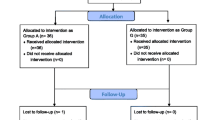Abstract
Achieving an adequate exposure in laryngoscopy is an extremely tedious task for the operating surgeon, especially for the anterior commissure lesions. Various maneuvers have been described to overcome this difficulty, but failed in providing an adequate exposure leading to a poor outcome. To create a device that can deliver uniform pressure over the laryngeal cartilage and succeed in providing an adequate exposure of the glottic lesion. A total of 44 patients were included in the study, divided into two groups containing 22 patients each. The distance at the level of anterior commissure from the superior border of the distal end of the laryngoscope was noted and compared. Group A subjected to digital cricoid pressure showed a mean distance of 9.09 of exposure with variance of 1.22 and Group B subjected to cricoid pressure with the cricoid catapult showed a mean distance of 11.76 with variance of 1.59. The groups were statistically analyzed using Anova Test and the test was found to be very significant (p < 0.0001). The catapult is made of a hanger defining its economics, which has a vital role in difficult intubations especially in anterior placed larynx, short neck and obese patients, also succeeds in providing an adequate exposure of the glottic lesion, (especially the anterior commissure) by delivering uniform pressure over the laryngeal cartilage, leading to a superior operative outcome.







Similar content being viewed by others
References
Joshi VM, Wadhwa V, Mukherji SK. Imaging in laryngeal cancers–Bизyaлизaция paкa гopтaни
Parkin DM, Bray F, Ferlay J, Pisani P (2005) Global cancer statistics, 2002. CA: A Cancer J Clin 55(2):74–108
Rucci L, Gammarota L, Gallo O (1996) Carcinoma of the anterior commissure of the larynx: II. Proposal of a new staging system. Ann Otol Rhinol Laryngol 105(5):391–396
El-Orbany M, Woehlck H, Salem MR (2011) Head and neck position for direct laryngoscopy. Anesth Analg 113(1):103–109
Reinhard M, Eberhardt E (1995) Alfred Kirstein (1863–1922) Pionier der direkten Laryngoskopie. AINS-Anästhesiologie· Intensivmedizin· Notfallmedizin· Schmerztherapie 30(04): 240–246
Zeitels SM, Vaughan CW, Domanowski GF (1990) Endoscopic management of early supraglottic cancer. Ann Otol Rhinol Laryngol 99(12):951–956
Woodrow JH (1971) Improved suspension laryngoscope for use with operative microscope. Trans Am Acad Ophthalmol Otolaryngol 75(2):412
Sataloff RT, Chowdhury F, Portnoy JE, Hawkshaw MJ, Joglekar S (2013) Surgical techniques in otolaryngology-head and neck surgery: laryngeal surgery. JP Medical Ltd
Cullen W, Cathcart W. A letter to lord cathcart… concerning the recovery of persons drowned and seemingly dead. C. Elliot; 1784
Sellick BA (1961) Cricoid pressure to control regurgitation of stomach contents during induction of anaesthesia. Lancet 278(7199):404–406
Benjamin B, Lindholm CE (2003) Systematic direct laryngoscopy: the Lindholm laryngoscopes. Ann Otol Rhinol Laryngol 112(9):787–797
Ralph SJ, Wareham CA (1991) Rupture of the oesophagus during cricoid pressure. Anaesthesia 46(1):40–41
Vanner RG, Pryle BJ (1992) Regurgitation and oesophageal rupture with cricoid pressure: a cActaver study. Anaesthesia 47(9):732–735
Gabbott DA (1997) The effect of single-handed cricoid pressure on neck movement after applying manual in-line stabilisation. Anaesthesia 52(6):586–588
Acknowledgement
I acknowledge the support of our head of the departments of ENT and Head & Neck Surgery and Anesthesia. I also acknowledge the support of nursing and technical staff who were involved in the process of surgery, postoperative care and other works. I also acknowledge all the patients who gave us consent and supported us for this. I acknowledge the immense help received from the scholars whose articles are cited and included in references of this manuscript. I am also grateful to the authors/editors/publishers of all those articles and journals from where the literature for this article has been reviewed and discussed. There were no special support sources/or grants used. There were no conflicts of interest.
Author information
Authors and Affiliations
Corresponding author
Ethics declarations
Conflict of interest
There is no conflict of interest.
Rights and permissions
About this article
Cite this article
Rengaraja, D., Jagade, M., Sonate, R. et al. “Hanger” in Intubation and Laryngoscopy. Indian J Otolaryngol Head Neck Surg 70, 591–596 (2018). https://doi.org/10.1007/s12070-018-1330-7
Received:
Accepted:
Published:
Issue Date:
DOI: https://doi.org/10.1007/s12070-018-1330-7




